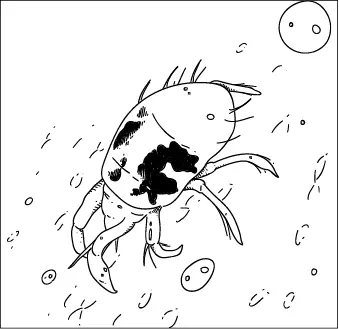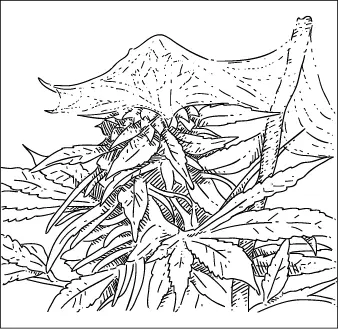CHAPTER 9
Dealing with Mites
Outdoor growers may deal with many more variables than the indoor grower, who, after all, can control light, water, wind, and humidity levels, but generally they do not have to battle spider mites. On the other hand, nothing strikes greater terror in the indoor grower than a spider mite infestation, which can lay siege to an entire crop.
Spider mites, predominantly the two-spotted spider mite (Tetranychus urticae) variety, are extremely destructive pests that mostly attack indoor cannabis grows. Although they are related to insects, spider mites are members of the arachnid class, along with spiders and ticks. Spider mites are sometimes called web-spinning mites and are the most common and destructive of mite pests. If you even suspect you have spider mites in your grow room, you must act quickly to protect your plants.
Spider mites reproduce rapidly in hot conditions like those found in a cannabis grow room; a generation can be completed in less than a week. After mating, mature females may produce a dozen eggs daily for a couple of weeks, leading to extremely rapid increases in spider mite populations. Plants under water stress are highly susceptible. As the food quality of your plant’s foliage declines, female spider mites hitchhike onwards to other plants, and the cycle continues.
Depending on your age and vision quality, to the naked eye, spider mites look like tiny moving dots on the plant leaves. They are so tiny that an initial infestation is easy to miss until you start seeing damage to the plants. For a clear look at suspicious dots, it is more efficient to examine your plants with a handheld lens with at least ten times magnification.
Keep It Simple
If you spot what you think are spider mites, shake a few off the leaf onto a white sheet of paper. Once you disturb them, they will move around rapidly.
You are looking for adults and eggs. The adult spider mites have eight legs and an oval body, with two red eyespots near the head end of the body. Adult females, which are the largest, are less than a twentieth of an inch long. Females usually have a large, dark blotch on each side of the body and numerous bristles covering the legs and body. The immature spider mites resemble the adults, except the newly hatched larvae have only six legs.

Spider mite.
Spider mites develop from eggs, which usually are laid near the veins of leaves during the growing season. Most spider mite eggs are round and extremely large in proportion to the size of the mother. Spider mite eggs are spherical and translucent; they look like tiny droplets of water that become cream colored just before hatching. After the eggs hatch, the old eggshells remain and can be useful in diagnosing spider mite problems. Check the underside of leaves for spider mites, their eggs, old eggshells, and the distinctive spider mite webbing.

An infested plant. Note that the webs are similar to those made by spiders.
Spider mites live in colonies frequently containing hundreds of individual mites that generally appear on the undersurfaces of leaves. The name “spider mite” probably comes from the silk webbing typically produced on infested leaves. The presence of this webbing is the easiest way to distinguish them from other types of mites. Lightly misting your plants before inspecting them will make the webs much easier to see.
Remember, you are looking for a very tiny spider-like creature, usually appearing in colonies; make sure that you do not destroy beneficial small garden spiders, usually those operating as helpful individuals, as it is sometimes easy to confuse their small useful webs with spider mite webbing.
Plant Indicators of Infestation
Spider mites cause damage by sucking cell contents from the plant’s leaves. Injury is caused as they feed, bruising the cells with their small, whip-like mouthparts and ingesting the sap. An infestation level high enough to show visible damage to leaves can be very destructive. The first visible signs of infestation show up as a stippling of light dots on the leaves; sometimes the leaves take on a sickly gray or bronze color. As the infestation continues, the plant’s leaves turn yellow and drop off. Leaves, twigs, and flowers become covered with large amounts of webbing, a most depressing and unpleasant sight.
This is where your careful inspections and notes about your plants will pay off. You are much more likely to notice the very beginning of a spider mite infestation because you will have trained yourself to observe every detail of the plants’ appearance. It is far better for the plants and your eventual harvest success if you spot the initial infestation and act quickly before it gets out of control. If you wait until your plants are covered with spider mite webbing, it is probably too late to save the plants.
What to Do If You Have Mites
Spider mites thrive in dryish conditions, approximately 20–30 percent humidity. They also crave warmth. In temperatures above 80°F, spider mites can reproduce themselves in as little as five days. The indoor cannabis grower has to walk a fine line between humidity levels that are unattractive to spider mites and the higher humidity desired by destructive molds that also plague cannabis, like botrytis or powdery mildew.
During the vegetative stage of cannabis growth, periodic blasts with a forceful jet of water can physically remove and kill many mites, as well as destroy the webbing. It is thought that spider mites may delay egg laying until new webbing is produced.
Treatment in an Isolation Ward
The very first preventative measure is to make certain you do not unknowingly bring infested plants in contact with your grow room or any cannabis plant, whether indoor or outdoor. Spider mites can live on plants other than cannabis, so any plants you handle or purchase should be inspected for spider mites, not just your cannabis.
Since the initial indications of spider mites are so tiny, it is possible that, with all good will in the world, another grower provides infested clones, perhaps at a compassion club event. Never put these new clones or plants in with your existing crop without a period of isolation where you can inspect them closely under magnification and give a preventative bath with an organic insecticidal soap. The insecticidal soap kills the spider mites by compromising their cellular integrity, and the spider mites are dissolved from the inside out.
Observe the new plants for at least a week, checking carefully under magnification for any sign of spider mites. If they pass as clean, give them one more treatment with the organic insecticidal bath, and transfer the plants out of isolation.
Money Smart
Make your own insecticidal soap with two to three drops of a soft, biodegradable soap (like Murphy Oil Soap, Castile, or Ivory liquid soap) per quart of water. Apply the bath by using a clean spray mister bottle, or with small clones, simply dip them into a wide-mouthed jar of the solution. If you are dealing with larger plants, make certain to cover every inch of the leaf, especially the undersides where spider mites prefer to live. You may have to repeat this every other day; the soap only stays effective for about a day.
If you find a really nasty infestation but still want to salvage the plants, you can use something a little stronger. Some growers recommend spraying plants with a 1:1 mixture of alcohol and water to kill spider mites on contact. Rubbing alcohol evaporates quickly and should do little damage to the plant, though it is advisable to test the spray on a few leaves first and check the plant’s reaction. Other growers prefer a 1:3 mixture of rubbing alcohol to water to make the spray gentler to the plants. As with the soap solution, make sure to cover the entire plant, especially the undersides of the leaves.
Читать дальше














